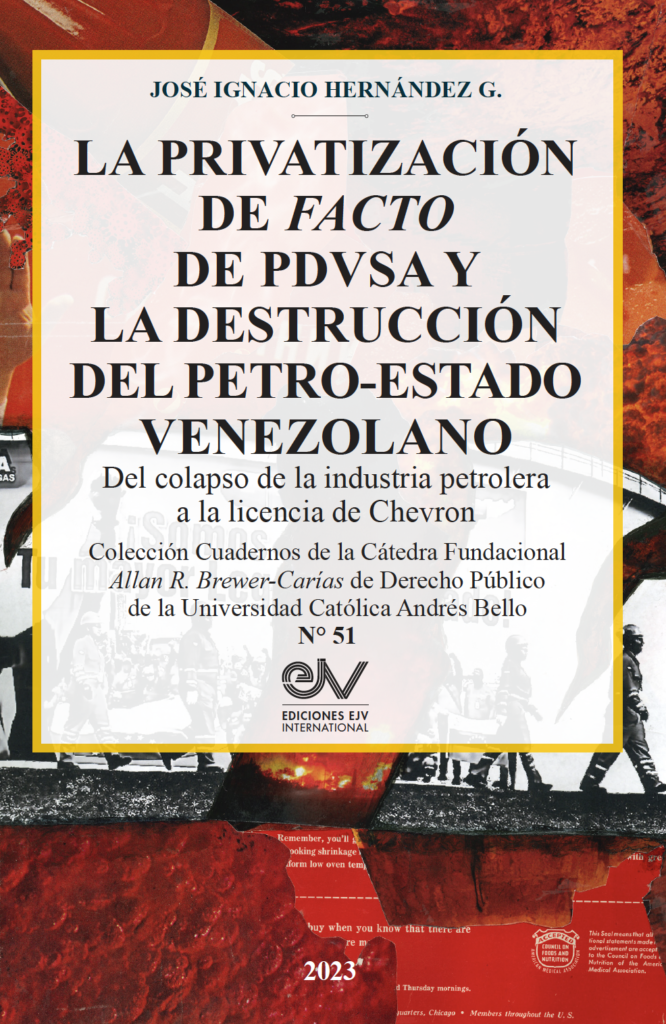The Chevron model and the Venezuelan economic recovery

The Venezuelan economic collapse started to slow down in 2018. Since 2021, the economy began to grow at a modest pace. Inflation -transformed into hyperinflation- also diminished around 2021. The economic improvement in Venezuela was considered, by many, a signal of a change in the economic policies towards a more pragmatic and private investment-friendly model.
As I analyze in my most recent book about the collapse of the Petro-State in Venezuela, the oil sector reflected this improvement. In 2010 oil production started to collapse, from 2853.6 thousand barrels per day (Mbbl) to 570 Mbbl in 2020. However, the collapse reversed in 2021: In May 2023 -based on OPEC‘s secondary sources- oil production rose 735 Mbbl.
As explained by Monaldi and Palacios, many factors (ranging from the dynamic of the oil market to geo-political considerations) can explain the recovery of the oil industry. Among those factors, in my book, I analyzed, with detail, which I call the de facto privation of the oil industry, that is, the transfer of assets and rights from PDVSA and its affiliates to private investors or foreign Governments, such as Iran, without the formalities prescribed in the Venezuelan Constitutional Law. Part of those arrangements includes illicit activities, as concluded by Transparencia Venezuela in 2022. The dimension of those illicit activities was evident in March 2023, with the kleptocracy scandals in PDVSA that could have affected 20 billion dollars.
The de facto privatization of PDVSA started in 2016 when the national oil corporation pledged all the shares of Citgo Holding Inc. to the 2020 Notes holders and Rosneft. In 2018, privatization paved the way for oil services agreements, in which private firms assumed activities that, according to the Constitution and the Organic Hydrocarbon Law, can only be conducted by PDVSA and its affiliates.
The last chapter of this de facto privatization is the technical service agreement (TSA) that, according to the media, was signed between Chevron and PDVSA after the Office for Foreign Assets Control (OFAC) granted General License 41 in November 2022. As I explained in my book -after carefully analyzing the available information- the GL 41 authorizes Chevron to conduct oil operations beyond the limited scope of activities that the firm can undertake as the minority shareholder of JVs. It seems that Chevron assumed the production, upgrading, and export of oil, basically, to collect its debt with PDVSA, related to the agreements signed in 2013 to increase its participation in oil activities.
The “Chevron model” refers, then, to the privatization of oil activities, that is, the transfer of rights and activities from PDVSA’s affiliates to private firms. This privatization is informal or de facto because it is not based on the reform of the Organic Hydrocarbon Law and the National Assembly’s Resolutions that authorize the creation of the JVs between PDVSA’s CVP and Chevron. That regulation prohibits Chevron from controlling production and export activities directly. However, those activities seem to be undertaken by Chevron.
Also, the oil industry privatization is a de facto process because it is not based on a privatization policy implemented following the legality and transparency principles. Indeed, there has not been a formal change in the current PDVSA policies, that at least in theory, are still based on the socialist model implemented in 2002 that destroyed the oil industry.
According to the PDVSA’s socialist policies and the hydrocarbon regulation, only the Venezuelan Government, through PDVSA and its affiliates, including the JVs, can undertake the production and export of oil. In practice, it looks like Chevron, based on GL 41 and the TSA, is controlling those transactions. Therefore, this de facto privatization is based on pragmatic reasons: due to its collapse, PDVSA cannot fulfill the operational and financial tasks that, according to the regulation still in force, must conduct. Therefore, those tasks were transferred to Chevron.
This is a good policy, but poorly implemented. As I have explained since 2018, it is necessary to repeal the legal constraints that prevent private investment from conducting primary oil activities (including production). PDVSA cannot face those investments and should be subject to a profound restructuring due to its civil and criminal liabilities. Therefore, Chevron and other national and international oil companies must assume those activities to rebuild the oil industry in Venezuela. But that will require a new institutional framework to ensure private rights, increase the legal certainty of the oil contracts, and fulfill international standards of transparency in extractive industries and environmental, social, and governance (ESG) standards.
However, there is no transparency in the Chevron agreements that, so far, are not public, nor have they been controlled by the National Assembly. There is no public information about how the government take is administered. Also, there is no transparency regarding the ESG standards -a weak point, considering the environmental damages attributable to the Government of Venezuela.
There are no shortcuts to promote the economic recovery of Venezuela. To catalyze inclusive and sustainable development, the “Chevron model” must move from the de facto scope to the jure one, fulfilling core principles embedded in the Constitution, such as legality, transparency, accountability, and social justice. The most challenging policy (allowing private firms in traditionally Government-controlled oil industry) was already implemented. Now is the time to transform Chevron into a model of inclusive development. For that purpose, Venezuela must learn the lessons of reinstating the rule of law under extreme conditions.